Did you know that noise-isolating headphones can block out mid to high-frequency noises by up to 30dB? On the other hand, noise-canceling headphones can reduce low-frequency sounds by about 30dB. In 2025, the debate between noise-canceling vs. sound-isolating headphones is still heated. Knowing the difference helps users choose the right headphones for their needs.
Whether you’re a frequent flyer or a musician, the right headphones matter. Noise-cancellation technology is great for low-frequency noises like airplane engines or traffic. It uses complex electrical circuitry and batteries to fight these sounds. Sound isolation, however, blocks out higher frequencies with a physical barrier, needing no power.
As technology keeps improving, picking the best headphones becomes more important. It’s all about finding the perfect balance for your lifestyle.
Key Takeaways
- Noise-canceling headphones: Use electronic circuitry to cut down low-frequency noises well.
- Sound-isolating headphones: Stop higher-frequency sounds with a physical design, saving energy.
- Energy consumption: Noise-canceling headphones need batteries, while sound-isolating ones don’t.
- User demographics: Travelers like noise-canceling, while musicians and everyday users prefer sound-isolating for its lightness.
- Price considerations: Basic noise-canceling headphones cost more than sound-isolating ones.
Understanding Noise-Canceling Technology
Noise-canceling headphones have changed how we hear sound. They use advanced tech to block out unwanted sounds. This makes listening better in noisy places.
How Noise-Canceling Works
Active noise cancellation (ANC) is the tech behind these headphones. It uses microphones and circuitry to work. The microphones pick up noise, and the circuitry makes a sound that cancels it out.
This sound is the opposite of the noise. It’s like a mirror image that cancels it out. This works best on low sounds like engine rumble or traffic.
Benefits of Noise-Canceling Headphones
Noise-canceling headphones are great for blocking out certain noises. They’re perfect for travel, commuting, or noisy offices. They make your listening experience better.
They also have modes that let you hear the outside world. This is useful for those who need to stay aware of their surroundings. They’re especially good for people who fly a lot or work in loud places.
Limitations of Noise-Canceling Technology
Even with their benefits, there are downsides. Not all models work the same, and some people find them uncomfortable. The tech can feel like pressure in your ears.
They also need batteries, which adds weight and requires charging. This can drain batteries fast. Also, they don’t block high-pitched sounds like alarms or babies crying.
Exploring Sound-Isolating Features
Sound-isolating headphones are popular among audio fans. They block outside noise in a special way. Unlike noise-canceling headphones, they don’t use electronics to cancel sound. Instead, they use design to keep out ambient noise.
This section looks at how they work, their benefits, and what they can’t do.
How Sound-Isolation Works
These headphones work by making a physical barrier. They use foam or rubber in the earpieces. These materials fit snugly around the ear, blocking out sound.
They’re great at stopping high-frequency noises. This makes listening quieter and more immersive.
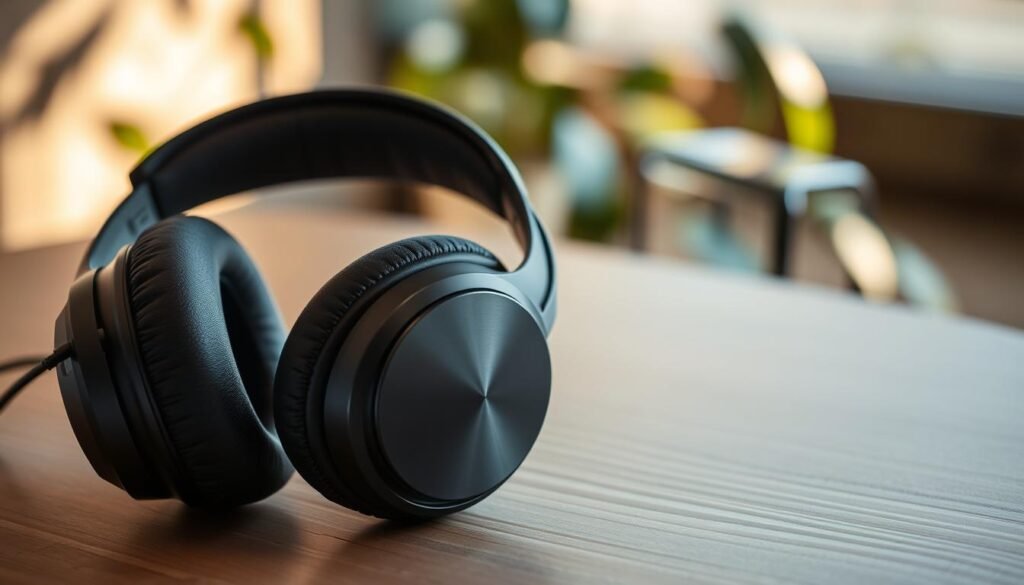
Benefits of Sound-Isolating Headphones
There are many good things about sound-isolating headphones:
- Energy Efficiency: They don’t need batteries or extra power. This makes them light and eco-friendly.
- Sound Quality: They keep the audio pure by blocking outside noise. This means better sound without any electronic mess.
- Durability and Comfort: They fit well and are made to last. This makes them comfortable to wear for a long time.
Limitations of Sound-Isolating Technology
But, there are some downsides:
- Ineffectiveness Against Low-Frequency Sounds: They don’t block low sounds well. This can be a problem in noisy places.
- Dependence on Fit: How well they work depends on a good fit. If they don’t fit right, they won’t block noise well.
In short, sound-isolating headphones are great for those who care about sound quality and saving energy. Knowing their good and bad points helps choose when to use them. They’re a great addition to any audio setup.
The Key Differences Between Noise-Canceling and Sound-Isolating Headphones
When we look at differences between noise cancelling and sound isolating headphones, it’s key to know how they work. Both types aim to cut down on unwanted noise. But, they do it in different ways, depending on where you use them and what you need.
Technology and Mechanisms
Noise-canceling headphones use noise reduction technology that’s active. They have microphones and electronics to fight ambient noise. This tech, called Active Noise Cancellation (ANC), works well against low sounds like engine rumbles.
Sound-isolating headphones, on the other hand, block sound with physical barriers like foam. They don’t need batteries or electronics to work. This makes them lighter and more energy-friendly.
Effectiveness in Various Environments
ANC headphones are great for places with constant low sounds, like planes or trains. They can cut down noise by 30 to 45 decibels. This makes them perfect for travelers who want better sound.
Sound-isolating headphones, though, are better at stopping higher sounds like voices or office noise. They can block mid to high sounds by 15 to 30 decibels. This makes them great for offices or places with occasional noise.
Energy Consumption and Battery Life
One big difference between noise cancelling and sound isolating headphones is energy use. ANC headphones need batteries for their tech, making them heavier and pricier. This extra power can also mean a higher cost.
Sound-isolating headphones don’t need batteries because they don’t use electronics. This makes them lighter and cheaper. They’re a good choice for those who want noise reduction without the need for charging.
Knowing these differences helps pick the right headphones for your needs. It’s about finding the right balance between noise reduction, energy use, and cost.
How to Choose the Best Option for Your Needs
Choosing between noise-canceling and sound-isolating headphones depends on your needs and preferences. Here are some key considerations to help you make an informed decision.
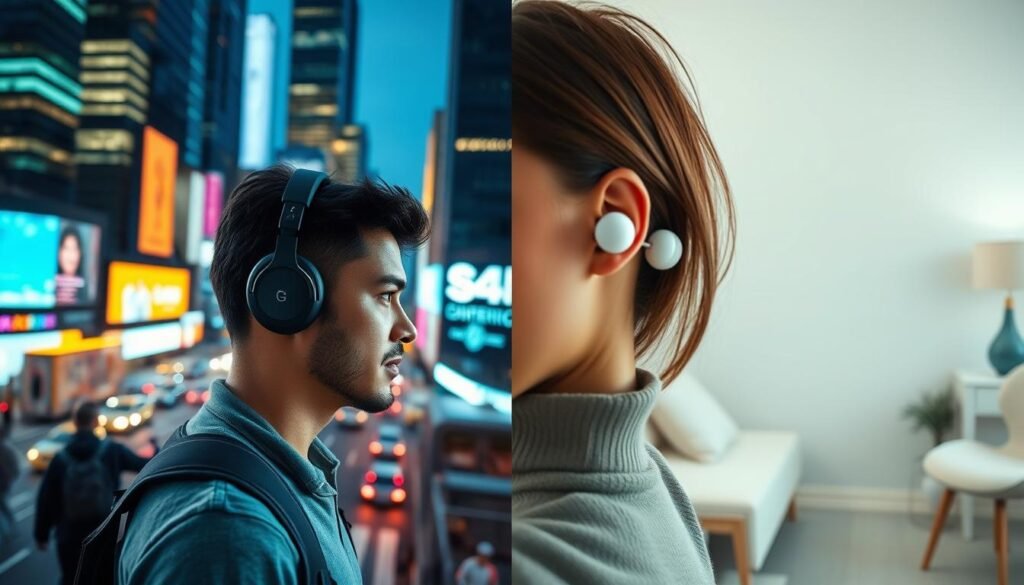
Usage environment is key. For example, noise-canceling headphones work well in places with constant low-frequency noise, like airplanes or busy trains. They can cut ambient noise by up to 30dB. High-end models, like the Liberty 4 NC Earbuds, block up to 95% of noise.
Sound-isolating headphones are better in quieter spots, like offices or home studios. They use physical barriers to block noise, reducing mid to high-frequency sounds by 15dB to 30dB. They offer better acoustics, making them popular among audiophiles.
Think about battery life and energy consumption. Noise-canceling headphones need charging because of their ANC technology. For example, the Liberty 4 NC Earbuds last between 10 to 50 hours. Sound-isolating headphones don’t need power, making them more energy-efficient and convenient for long use.
Consider your sensitivity to sound quality. Both types aim to improve your listening experience but in different ways. Noise isolation blocks sound passively and is lighter. ANC actively cancels noise using microphones and circuitry. This makes ANC headphones great for noisy places, helping protect your hearing by letting you listen at lower volumes.
To help you decide, here’s a detailed comparison:
| Criteria | Best Noise-Canceling Headphones | Top Sound-Isolating Headphones |
|---|---|---|
| Noise Reduction | Up to 95%, effective for low-frequency sounds | Reduces 15dB to 30dB, better for high-frequency sounds |
| Power Requirements | Requires charging, variable battery life (e.g., 10-50 hours) | No charging needed |
| Weight | Heavier due to electronic components | Lighter, no battery or electronics |
| Price | Generally more expensive due to ANC technology | Usually more affordable |
| Usage Environments | Ideal for travel and noisy settings | Best for offices, studios, and quiet places |
Choosing between noise-canceling and sound-isolating headphones depends on your environment, sound sensitivity, and lifestyle. Consider these factors to find your perfect match.
Best Noise-Canceling Headphones for 2025
In 2025, the need for top-notch noise-canceling headphones is higher than ever. Whether you travel often, work in a busy office, or love great sound, there are amazing choices. Let’s explore the best active noise cancellation headphones for 2025, tailored for different needs.
Top Picks for Travelers
Travelers need headphones that block out airplane noise and terminal chatter. The Bose QuietComfort Ultra headphones are a top pick, with an ANC score of 87. They offer 29 hours of battery life, so you can enjoy peace even on long flights.
The Sony WH-1000XM4 is another great choice. It lasts over 37 hours with ANC on. This means you can stay calm, whether you’re flying or waiting for a flight.
Best for Office Use
In the office, noise-canceling headphones help you focus. The Anker Soundcore Space Q45 is a standout, with effective ANC and 27 hours of battery. It also pairs easily with your devices, keeping you connected and productive.
The Anker Soundcore Life Q30 also shines, especially against office noises. It lasts 44 hours, making it perfect for long workdays.
High-End Recommendations
For luxury and top sound, several high-end models stand out. The Mark Levinson No. 5909 costs $999 but offers unmatched sound and noise canceling. The Focal Bathys at $699 provides great sound but with less noise canceling.
The Shure Aonic 50 Gen 2 lasts about 45 hours and has strong ANC. It’s a bit heavier but quick to charge and comfortable.
2025 offers many active noise cancellation headphones for every need. Whether you’re traveling, working, or enjoying music, you’ll find the perfect pair.
Top Sound-Isolating Headphones for 2025
Looking for the best sound-isolating headphones is key in today’s world. We’ve found top picks for musicians, everyday users, and those on a budget.
Ideal Options for Musicians
Musicians need clear sound and good noise isolation. The Sony WH-1000XM4 is great, with sound from 4Hz to 40kHz. It’s light at 253g and lasts 30 hours, perfect for long sessions.
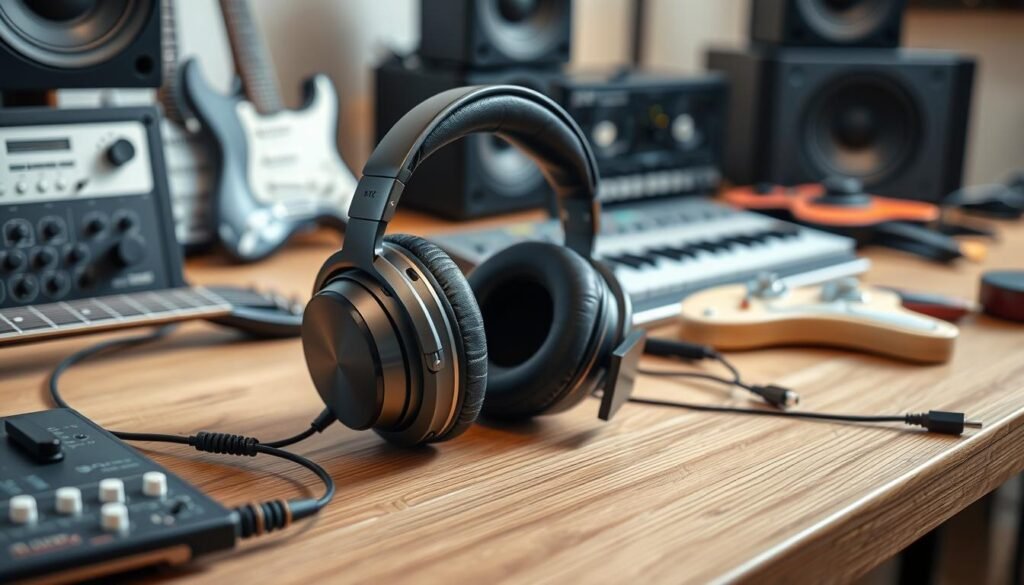
The 1More Sonoflow is another great choice. It lasts 50 hours with ANC on and 70 hours off. It’s light and charges fast, offering a wide range of sounds for musicians.
Best for Everyday Use
For everyday use, look for comfort and durability. The Cambridge Audio Melomania P100 lasts 100 hours without ANC and 60 hours with. It’s light and comfy for long wear.
The Bose QuietComfort Ultra Headphones are also top-notch. They’re comfy and sound great, priced at $429.00. The Bose QuietComfort Ultra Earbuds are $299.00 and known for blocking low-frequency noise.
Budget-Friendly Choices
For those watching their budget, quality matters. The Anker Soundcore Liberty 4 Pro is around $100. It offers great sound and noise isolation for a low price.
The Urbanista Los Angeles headphones are now $119.95, down from $199.00. They’re affordable and offer quality sound isolation, making them a great choice.
| Model | Battery Life | Frequency Response | Weight | Rating |
|---|---|---|---|---|
| Sony WH-1000XM4 | 30 hours | 4Hz to 40kHz | 253g | N/A |
| 1More Sonoflow | 50-70 hours | 2.400GHz – 2.4835GHz | 250g | N/A |
| Cambridge Audio Melomania P100 | 60-100 hours | N/A | N/A | N/A |
| Bose QuietComfort Ultra Headphones | N/A | N/A | N/A | 4.5/5 |
| Bose QuietComfort Ultra Earbuds | N/A | N/A | N/A | 4.5/5 |
| Anker Soundcore Liberty 4 Pro | N/A | N/A | N/A | N/A |
| Urbanista Los Angeles | N/A | N/A | N/A | N/A |
Noise-Canceling vs. Sound-Isolating Headphones: Which is Better for You?
Choosing the right headphones can greatly enhance your listening experience. Whether you’re at home, at work, or traveling, the right choice depends on your needs. Noise-canceling and sound-isolating headphones each have their own strengths.
Active Noise Cancelling (ANC) headphones use microphones and electronics to block out low sounds like airplane engines. They’re great for travelers and anyone in noisy places. The House of Marley’s Positive Vibration XL ANC Wireless Headphones are known for their ability to reduce distractions.
Sound-isolating headphones, by contrast, block sound with physical barriers like foam. They’re good at stopping high-frequency sounds and don’t need batteries. This makes them a great choice for those who want something simple and energy-efficient.
| Features | Noise-Canceling Headphones | Sound-Isolating Headphones |
|---|---|---|
| Noise Reduction | 30 to 45 dB (low-frequency) | 15 to 30 dB (mid to high-frequency) |
| Power Requirement | Yes (battery needed) | No (battery-free) |
| Weight | Heavier | Lighter |
| Effective in | Environments with constant noise (airplanes, buses) | Quieter environments (libraries, homes) |
| Cost | Higher (due to technology) | More affordable |
Deciding which headphones are better for blocking out noise depends on where you listen most. ANC headphones are best for those in noisy places like airplanes. For quieter spots, sound-isolating headphones offer simplicity and comfort without extra power.
Expert Opinions and User Reviews
When choosing between noise-canceling and sound-isolating headphones, expert advice and user feedback are key. We’ve gathered insights from both seasoned audiophiles and everyday users. This gives you a complete view of what’s out there.
Insights from Audiophiles
Experts often suggest the Bose QuietComfort Ultra earbuds for their top-notch noise cancellation. They’re great at blocking out loud noises like airplane engines. This makes them perfect for quieter commutes or workspaces.
However, some say the battery life is a bit short, lasting about six hours. But, the charging case adds extra power, making up for this.
The Sony LinkBuds Fit also get high praise. They offer a wide sound range and last up to 5.5 hours on a single charge. Their IPX4 rating means they’re also waterproof, standing up to sweat and splashes.
But, some users have run into connectivity problems. It’s important to charge them fully for the best performance.
The AirPods Pro (2nd generation) are another favorite. They have twice the noise cancellation of older models and last 33% longer. This makes them a great choice for those who want both quiet and long battery life.
Consumer Feedback and Ratings
People love the Sennheiser Accentum True Wireless earbuds for their sound quality and ANC. Even though the battery life isn’t clear, their reliability and sound make them popular.
The JLab JBuds ANC 3 are also well-liked. They offer great noise cancellation at a lower price. With a battery life of nine hours from the earbuds alone, they’re great for long listening sessions.
Our research includes noise isolation tests. For example, some top ANC headphones can block over 15 dB of noise. This is especially useful for low frequencies like bus and plane engines.
To wrap it up, experts highlight the advanced features of noise-canceling headphones. But, user reviews show sound-isolating headphones are great for everyday use. Here’s a table comparing some of the top headphones:
| Headphone Model | Noise Cancellation | Battery Life (Earbuds) | Additional Features |
|---|---|---|---|
| Bose QuietComfort Ultra | Top-tier | 6 hours | Connectivity issues when insufficiently charged |
| Sony LinkBuds Fit | High | 5.5 hours | IPX4 waterproof |
| AirPods Pro (2nd Gen) | Two times previous models | 6 hours | 33% longer battery life |
| JLab JBuds ANC 3 | Competitive | 9 hours | 33 hours with case, budget-friendly |
| Sennheiser Accentum True Wireless | Exceptional | Not specified | Exceptional sound quality |
Conclusion
In the world of personal audio, noise-canceling and sound-isolating headphones have their own strengths. Noise-canceling tech is great for blocking steady, low sounds like background hums. This makes it perfect for travelers or those in noisy offices.
Sound-isolating headphones, on the other hand, block all kinds of noise. They’re great for listening to music or taking online meetings. This makes them very versatile.
It’s key to remember that noise-canceling headphones need batteries. This adds to their upkeep. Sound-isolating headphones, like Shure’s, don’t need batteries. They’re easier to use and maintain.
Price also matters. Noise-canceling headphones can cost a lot more than sound-isolating ones. But, high-end ANC headphones offer better noise reduction and features. This might be worth it for some.
Choosing between noise-canceling and sound-isolating headphones depends on your needs. If you’re often in loud places, ANC headphones might help you focus. Sound-isolating headphones are a good choice if you want something affordable and effective for all kinds of noise.
We suggest trying out different headphones to find the right one for you. It’s all about matching your lifestyle and preferences with the right audio companion.

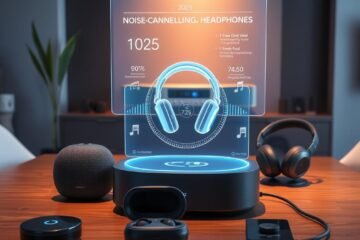
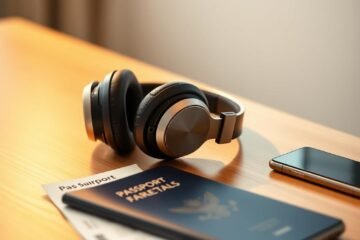
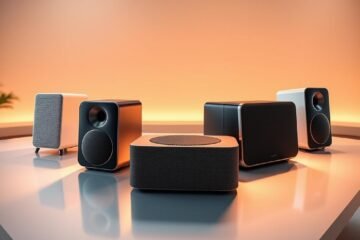
![Best Audiophile Over-Ear Headphones in 2025 [Top 5]](https://fataimm.com/wp-content/uploads/2025/06/audiophile-over-ear-headphones-in-2025-360x240.jpeg)
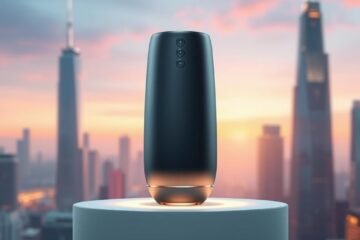
![Best Smart Audio Gadgets for Seniors in 2025 [Top Picks]](https://fataimm.com/wp-content/uploads/2025/05/smart-audio-gadgets-for-seniors-360x240.jpeg)